實(shí)驗(yàn)環(huán)境配置
HOST文件配置如下:
127.0.0.1 app.com
127.0.0.1 sso.com
IIS配置如下:

應(yīng)用程序池采用.Net Framework 4.0
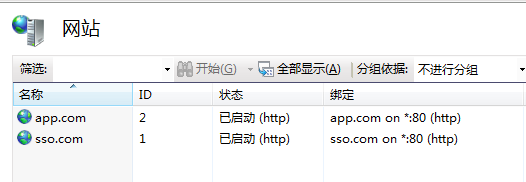
注意IIS綁定的域名,兩個(gè)完全不同域的域名。
app.com網(wǎng)站配置如下:

sso.com網(wǎng)站配置如下:
memcached緩存:

數(shù)據(jù)庫(kù)配置:

數(shù)據(jù)庫(kù)采用EntityFramework 6.0.0,首次運(yùn)行會(huì)自動(dòng)創(chuàng)建相應(yīng)的數(shù)據(jù)庫(kù)和表結(jié)構(gòu)。
授權(quán)驗(yàn)證過(guò)程演示:
在瀏覽器地址欄中訪問(wèn):http://app.com,如果用戶(hù)還未登陸則網(wǎng)站會(huì)自動(dòng)重定向至:http://sso.com/passport,同時(shí)通過(guò)QueryString傳參數(shù)的方式將對(duì)應(yīng)的AppKey應(yīng)用標(biāo)識(shí)傳遞過(guò)來(lái),運(yùn)行截圖如下:
URL地址:http://sso.com/passport?appkey=670b14728ad9902aecba32e22fa4f6bd&username=
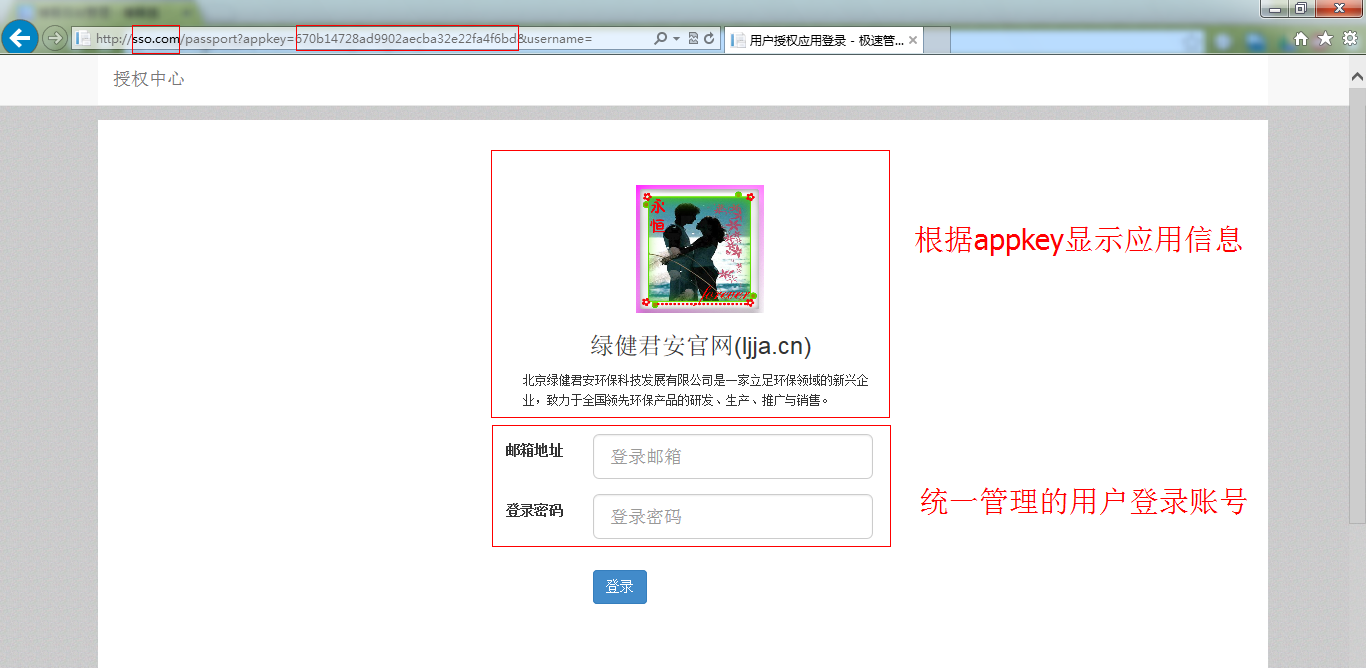
輸入正確的登陸賬號(hào)和密碼后,點(diǎn)擊登陸按鈕系統(tǒng)自動(dòng)301重定向至應(yīng)用會(huì)掉首頁(yè),毀掉成功后如下所示:
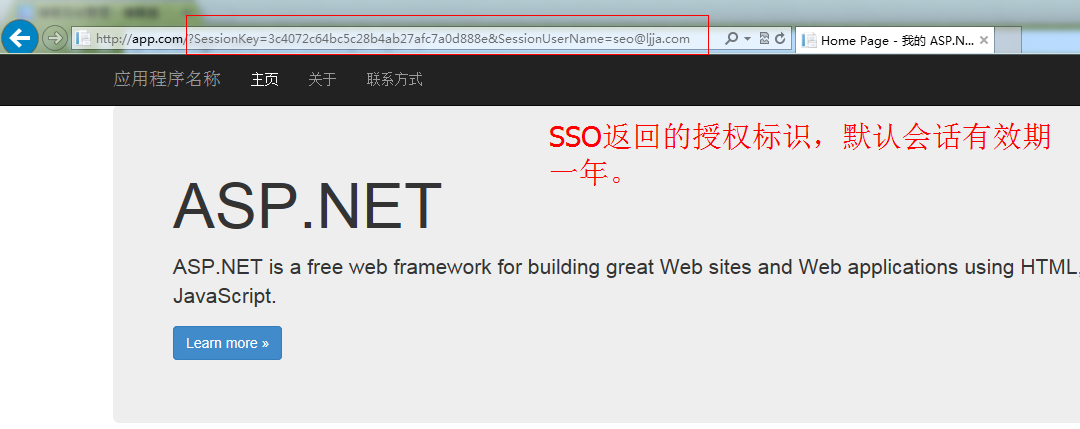
由于在不同的域下進(jìn)行SSO授權(quán)登陸,所以采用QueryString方式返回授權(quán)標(biāo)識(shí)。同域網(wǎng)站下可采用Cookie方式。由于301重定向請(qǐng)求是由瀏覽器發(fā)送的,所以在如果授權(quán)標(biāo)識(shí)放入Handers中的話(huà),瀏覽器重定向的時(shí)候會(huì)丟失。重定向成功后,程序自動(dòng)將授權(quán)標(biāo)識(shí)寫(xiě)入到Cookie中,點(diǎn)擊其他頁(yè)面地址時(shí),URL地址欄中將不再會(huì)看到授權(quán)標(biāo)示信息。Cookie設(shè)置如下:
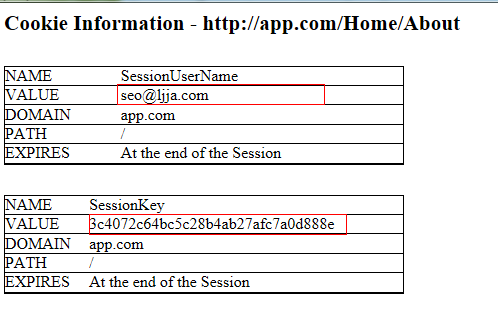
登陸成功后的后續(xù)授權(quán)驗(yàn)證(訪問(wèn)其他需要授權(quán)訪問(wèn)的頁(yè)面):
校驗(yàn)地址:http://sso.com/api/passport?sessionkey=xxxxxx&remark=xxxxxx
返回結(jié)果:true,false
客戶(hù)端可以根據(jù)實(shí)際業(yè)務(wù)情況,選擇提示用戶(hù)授權(quán)已丟失,需要重新獲得授權(quán)。默認(rèn)自動(dòng)重定向至SSO登陸頁(yè)面,即:http://sso.com/passport?appkey=670b14728ad9902aecba32e22fa4f6bd&[email protected] 同時(shí)登陸頁(yè)面郵箱地址文本框會(huì)自定補(bǔ)全用戶(hù)的登陸賬號(hào),用戶(hù)只需輸入登陸密碼即可,授權(quán)成功后會(huì)話(huà)有效期自動(dòng)延長(zhǎng)一年時(shí)間。
SSO數(shù)據(jù)庫(kù)驗(yàn)證日志:
用戶(hù)授權(quán)驗(yàn)證日志:
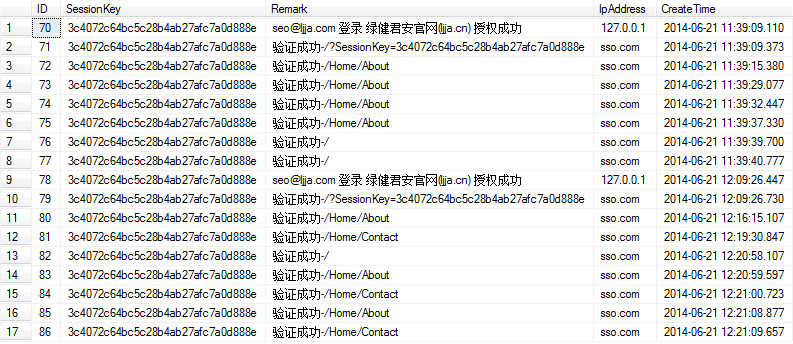
用戶(hù)授權(quán)會(huì)話(huà)Session:

數(shù)據(jù)庫(kù)用戶(hù)賬號(hào)和應(yīng)用信息:

應(yīng)用授權(quán)登陸驗(yàn)證頁(yè)面核心代碼:
1 /// <summary> 2 /// 公鑰:AppKey 3 /// 私鑰:AppSecret 4 /// 會(huì)話(huà):SessionKey 5 /// </summary> 6 public class PassportController : Controller 7 { 8 private readonly IAppInfoService _appInfoService = new AppInfoService(); 9 private readonly IAppUserService _appUserService = new AppUserService(); 10 private readonly IUserAuthSessionService _authSessionService = new UserAuthSessionService(); 11 private readonly IUserAuthOperateService _userAuthOperateService = new UserAuthOperateService(); 12 13 private const string AppInfo = "AppInfo"; 14 private const string SessionKey = "SessionKey"; 15 private const string SessionUserName = "SessionUserName"; 16 17 //默認(rèn)登錄界面 18 public ActionResult Index(string appKey = "", string username = "") 19 { 20 TempData[AppInfo] = _appInfoService.Get(appKey); 21 22 var viewModel = new PassportLoginRequest 23 { 24 AppKey = appKey, 25 UserName = username 26 }; 27 28 return View(viewModel); 29 } 30 31 //授權(quán)登錄 32 [HttpPost] 33 public ActionResult Index(PassportLoginRequest model) 34 { 35 //獲取應(yīng)用信息 36 var appInfo = _appInfoService.Get(model.AppKey); 37 if (appInfo == null) 38 { 39 //應(yīng)用不存在 40 return View(model); 41 } 42 43 TempData[AppInfo] = appInfo; 44 45 if (ModelState.IsValid == false) 46 { 47 //實(shí)體驗(yàn)證失敗 48 return View(model); 49 } 50 51 //過(guò)濾字段無(wú)效字符 52 model.Trim(); 53 54 //獲取用戶(hù)信息 55 var userInfo = _appUserService.Get(model.UserName); 56 if (userInfo == null) 57 { 58 //用戶(hù)不存在 59 return View(model); 60 } 61 62 if (userInfo.UserPwd != model.Password.ToMd5()) 63 { 64 //密碼不正確 65 return View(model); 66 } 67 68 //獲取當(dāng)前未到期的Session 69 var currentSession = _authSessionService.ExistsByValid(appInfo.AppKey, userInfo.UserName); 70 if (currentSession == null) 71 { 72 //構(gòu)建Session 73 currentSession = new UserAuthSession 74 { 75 AppKey = appInfo.AppKey, 76 CreateTime = DateTime.Now, 77 InvalidTime = DateTime.Now.AddYears(1), 78 IpAddress = Request.UserHostAddress, 79 SessionKey = Guid.NewGuid().ToString().ToMd5(), 80 UserName = userInfo.UserName 81 }; 82 83 //創(chuàng)建Session 84 _authSessionService.Create(currentSession); 85 } 86 else 87 { 88 //延長(zhǎng)有效期,默認(rèn)一年 89 _authSessionService.ExtendValid(currentSession.SessionKey); 90 } 91 92 //記錄用戶(hù)授權(quán)日志 93 _userAuthOperateService.Create(new UserAuthOperate 94 { 95 CreateTime = DateTime.Now, 96 IpAddress = Request.UserHostAddress, 97 Remark = string.Format("{0} 登錄 {1} 授權(quán)成功", currentSession.UserName, appInfo.Title), 98 SessionKey = currentSession.SessionKey 99 }); 104 105 var redirectUrl = string.Format("{0}?SessionKey={1}&SessionUserName={2}", 106 appInfo.ReturnUrl, 107 currentSession.SessionKey, 108 userInfo.UserName); 109 110 //跳轉(zhuǎn)默認(rèn)回調(diào)頁(yè)面 111 return Redirect(redirectUrl); 112 } 113 }
Memcached會(huì)話(huà)標(biāo)識(shí)驗(yàn)證核心代碼:
public class PassportController : ApiController { private readonly IUserAuthSessionService _authSessionService = new UserAuthSessionService(); private readonly IUserAuthOperateService _userAuthOperateService = new UserAuthOperateService(); public bool Get(string sessionKey = "", string remark = "") { if (_authSessionService.GetCache(sessionKey)) { _userAuthOperateService.Create(new UserAuthOperate { CreateTime = DateTime.Now, IpAddress = Request.RequestUri.Host, Remark = string.Format("驗(yàn)證成功-{0}", remark), SessionKey = sessionKey }); return true; } _userAuthOperateService.Create(new UserAuthOperate { CreateTime = DateTime.Now, IpAddress = Request.RequestUri.Host, Remark = string.Format("驗(yàn)證失敗-{0}", remark), SessionKey = sessionKey }); return false; } }
Client授權(quán)驗(yàn)證Filters Attribute
public class SSOAuthAttribute : ActionFilterAttribute { public const string SessionKey = "SessionKey"; public const string SessionUserName = "SessionUserName"; public override void OnActionExecuting(ActionExecutingContext filterContext) { var cookieSessionkey = ""; var cookieSessionUserName = ""; //SessionKey by QueryString if (filterContext.HttpContext.Request.QueryString[SessionKey] != null) { cookieSessionkey = filterContext.HttpContext.Request.QueryString[SessionKey]; filterContext.HttpContext.Response.Cookies.Add(new HttpCookie(SessionKey, cookieSessionkey)); } //SessionUserName by QueryString if (filterContext.HttpContext.Request.QueryString[SessionUserName] != null) { cookieSessionUserName = filterContext.HttpContext.Request.QueryString[SessionUserName]; filterContext.HttpContext.Response.Cookies.Add(new HttpCookie(SessionUserName, cookieSessionUserName)); } //從Cookie讀取SessionKey if (filterContext.HttpContext.Request.Cookies[SessionKey] != null) { cookieSessionkey = filterContext.HttpContext.Request.Cookies[SessionKey].Value; } //從Cookie讀取SessionUserName if (filterContext.HttpContext.Request.Cookies[SessionUserName] != null) { cookieSessionUserName = filterContext.HttpContext.Request.Cookies[SessionUserName].Value; } if (string.IsNullOrEmpty(cookieSessionkey) || string.IsNullOrEmpty(cookieSessionUserName)) { //直接登錄 filterContext.Result = SsoLoginResult(cookieSessionUserName); } else { //驗(yàn)證 if (CheckLogin(cookieSessionkey, filterContext.HttpContext.Request.RawUrl) == false) { //會(huì)話(huà)丟失,跳轉(zhuǎn)到登錄頁(yè)面 filterContext.Result = SsoLoginResult(cookieSessionUserName); } } base.OnActionExecuting(filterContext); } public static bool CheckLogin(string sessionKey, string remark = "") { var httpClient = new HttpClient { BaseAddress = new Uri(ConfigurationManager.AppSettings["SSOPassport"]) }; var requestUri = string.Format("api/Passport?sessionKey={0}&remark={1}", sessionKey, remark); try { var resp = httpClient.GetAsync(requestUri).Result; resp.EnsureSuccessStatusCode(); return resp.Content.ReadAsAsync<bool>().Result; } catch (Exception ex) { throw ex; } } private static ActionResult SsoLoginResult(string username) { return new RedirectResult(string.Format("{0}/passport?appkey={1}&username={2}", ConfigurationManager.AppSettings["SSOPassport"], ConfigurationManager.AppSettings["SSOAppKey"], username)); } }
示例SSO驗(yàn)證特性使用方法:
[SSOAuth] public class HomeController : Controller { public ActionResult Index() { return View(); } public ActionResult About() { ViewBag.Message = "Your application description page."; return View(); } public ActionResult Contact() { ViewBag.Message = "Your contact page."; return View(); } }
總結(jié):
從草稿示例代碼中可以看到代碼性能上還有很多優(yōu)化的地方,還有SSO應(yīng)用授權(quán)登陸頁(yè)面的用戶(hù)賬號(hào)不存在、密碼錯(cuò)誤等一系列的提示信息等。在業(yè)務(wù)代碼運(yùn)行基本正確的后期,可以考慮往更多的安全性層面優(yōu)化,比如啟用AppSecret私鑰簽名驗(yàn)證,IP范圍驗(yàn)證,固定會(huì)話(huà)請(qǐng)求攻擊、SSO授權(quán)登陸界面的驗(yàn)證碼、會(huì)話(huà)緩存自動(dòng)重建、SSo服務(wù)器、緩存的水平擴(kuò)展等。
源碼地址:https://github.com/smartbooks/SmartSSO
以上就是本文的全部?jī)?nèi)容,希望對(duì)大家的學(xué)習(xí)有所幫助,也希望大家多多支持服務(wù)器之家。
原文鏈接:http://www.cnblogs.com/smartbooks/p/3800849.html












